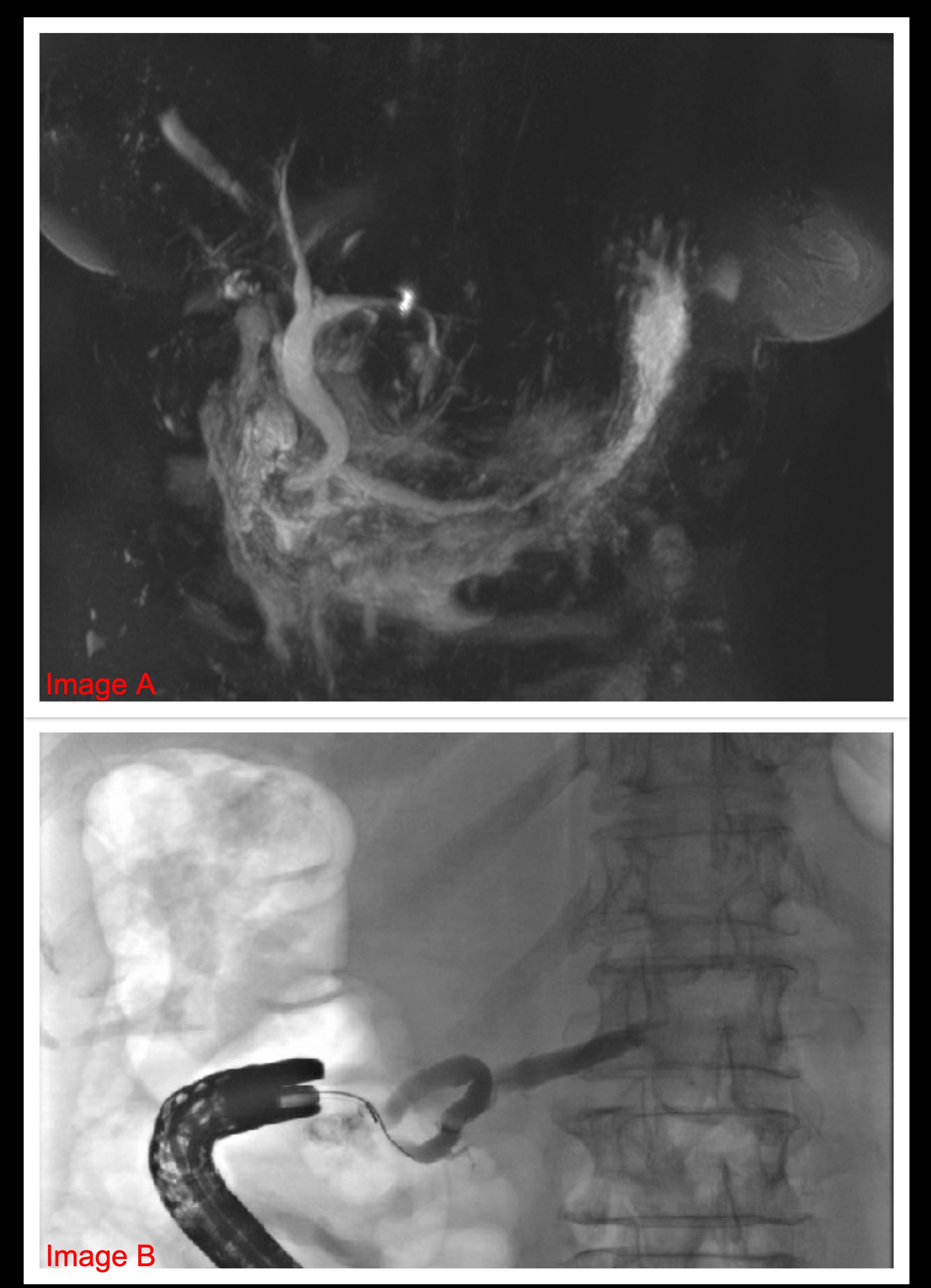Back


Poster Session C - Monday Afternoon
Category: Biliary/Pancreas
C0070 - ANSA Pancreatica and Recurrent Acute Interstitial Pancreatitis: An Emerging Anatomic Variant
Monday, October 24, 2022
3:00 PM – 5:00 PM ET
Location: Crown Ballroom

Has Audio

Michael Kalinowski, DO, MBA, MS
Aurora Health Care
Milwaukee, WI
Presenting Author(s)
Michael Kalinowski, DO, MBA, MS, Ahmed Akhter, MD
Aurora Health Care, Milwaukee, WI
Introduction: Ansa pancreatica is a rare anatomic variant that has been associated with an increased risk of developing acute interstitial pancreatitis. We present a case of recurrent pancreatitis and ansa pancreatica diagnosed on endoscopic retrograde pancreatography (ERCP).
Case Description/Methods: Patient is a 76-year-old female with history of gallstone pancreatitis status-post cholecystectomy who presented with epigastric pain and associated nausea and vomiting. Patient denied alcohol use. Patient's lipase was 14,406 unit/L and triglyceride level was normal. A computerized tomography with contrast revealed evidence of acute interstitial pancreatitis, a dilated pancreatic duct of 7mm, concern for pancreatic duct stone, and intra- and extra-hepatic duct dilation. Patient underwent MRI of the abdomen with and without contrast which revealed pancreatic duct dilation and a pancreatic duct stone. There was irregular calcific appearing abnormality on the right lateral margin of the pancreatic head near the minor papilla. There were no imaging findings to suggest a mass lesion and no choledocholithiasis. The patient was medically treated with intravenous fluids, diet was advanced, and the patient was discharged with plans for outpatient ERCP.
ERCP was performed two months after admission for acute pancreatitis. Pancreatic duct cannulation was achieved with a DASH spincterotome and revealed ansa pancreatica with a dominant draining dorsal duct. A filling defect was apparent in the duct of Santorini and a pancreatic sphincterotomy was performed at the major papilla. The minor papilla was cannulated and stone debris was removed following a minor papillotomy. Patient tolerated the procedure without incident. To date, the patient has not had a recurrence of their acute pancreatitis.
Discussion: We present a case of recurrent pancreatitis secondary to suspected ansa pancreatica. Ansa pancreatica is a rare anatomic variant, prevalence of 0.5-0.9%, described as an "S shaped loop" connecting the accessory pancreatic duct to the main pancreatic duct (1-6). There is an association between acute pancreatitis and ansa pancreatica, however, the mechanism is not well understood. This case highlights the anatomic variant specific to a dominant dorsal draining duct treated with a minor papillotomy and stone extraction. Further investigation is needed to address endoscopic cannulation of this anatomic variant and the association with acute pancreatitis.

Disclosures:
Michael Kalinowski, DO, MBA, MS, Ahmed Akhter, MD. C0070 - ANSA Pancreatica and Recurrent Acute Interstitial Pancreatitis: An Emerging Anatomic Variant, ACG 2022 Annual Scientific Meeting Abstracts. Charlotte, NC: American College of Gastroenterology.
Aurora Health Care, Milwaukee, WI
Introduction: Ansa pancreatica is a rare anatomic variant that has been associated with an increased risk of developing acute interstitial pancreatitis. We present a case of recurrent pancreatitis and ansa pancreatica diagnosed on endoscopic retrograde pancreatography (ERCP).
Case Description/Methods: Patient is a 76-year-old female with history of gallstone pancreatitis status-post cholecystectomy who presented with epigastric pain and associated nausea and vomiting. Patient denied alcohol use. Patient's lipase was 14,406 unit/L and triglyceride level was normal. A computerized tomography with contrast revealed evidence of acute interstitial pancreatitis, a dilated pancreatic duct of 7mm, concern for pancreatic duct stone, and intra- and extra-hepatic duct dilation. Patient underwent MRI of the abdomen with and without contrast which revealed pancreatic duct dilation and a pancreatic duct stone. There was irregular calcific appearing abnormality on the right lateral margin of the pancreatic head near the minor papilla. There were no imaging findings to suggest a mass lesion and no choledocholithiasis. The patient was medically treated with intravenous fluids, diet was advanced, and the patient was discharged with plans for outpatient ERCP.
ERCP was performed two months after admission for acute pancreatitis. Pancreatic duct cannulation was achieved with a DASH spincterotome and revealed ansa pancreatica with a dominant draining dorsal duct. A filling defect was apparent in the duct of Santorini and a pancreatic sphincterotomy was performed at the major papilla. The minor papilla was cannulated and stone debris was removed following a minor papillotomy. Patient tolerated the procedure without incident. To date, the patient has not had a recurrence of their acute pancreatitis.
Discussion: We present a case of recurrent pancreatitis secondary to suspected ansa pancreatica. Ansa pancreatica is a rare anatomic variant, prevalence of 0.5-0.9%, described as an "S shaped loop" connecting the accessory pancreatic duct to the main pancreatic duct (1-6). There is an association between acute pancreatitis and ansa pancreatica, however, the mechanism is not well understood. This case highlights the anatomic variant specific to a dominant dorsal draining duct treated with a minor papillotomy and stone extraction. Further investigation is needed to address endoscopic cannulation of this anatomic variant and the association with acute pancreatitis.

Figure: Image A. MRCP demonstrating ansa pancreatica. Image B. ERCP demonstrating ansa pancreatica.
Disclosures:
Michael Kalinowski indicated no relevant financial relationships.
Ahmed Akhter indicated no relevant financial relationships.
Michael Kalinowski, DO, MBA, MS, Ahmed Akhter, MD. C0070 - ANSA Pancreatica and Recurrent Acute Interstitial Pancreatitis: An Emerging Anatomic Variant, ACG 2022 Annual Scientific Meeting Abstracts. Charlotte, NC: American College of Gastroenterology.

